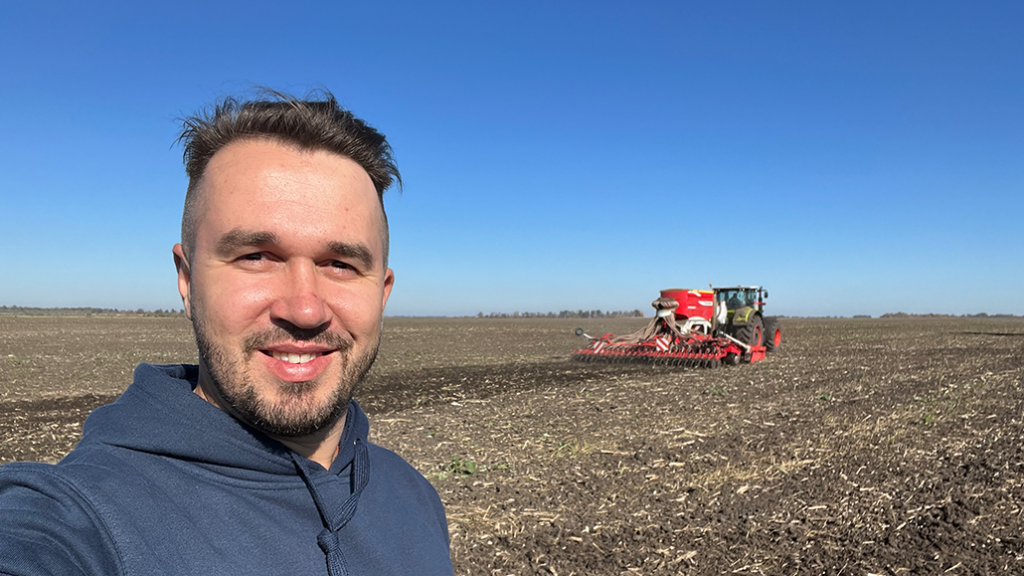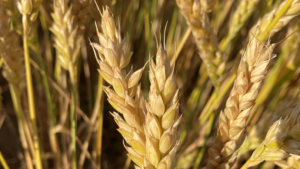Farming in a war zone
UKRAINE FARMERS CONTINUE TO BE RESILIENT

IN JUNE OF this year, Ontario Grain Farmer published a story on the challenges faced by Ukrainian farmers amidst the growing conflict with Russia. First interviewed in April, Oleh Zahorodnii and Roman Gorobets provide an update in follow-up interviews on the situation in Ukraine and how it is impacting their farm businesses.
OUT OF DANGER, BUT CHALLENGES MOUNT
Oleh Zahorodnii is the chief agronomist of a large agricultural company in Ukraine called Agro Expert. The company supplies local farmers with seed, fertilizer, plant protection products, and machinery. Agro Expert also cultivates nearly 2,500 acres in the region of Vinnytsia. Zahorodnii also tends the home farm where he grows corn, soybeans, wheat and echinacea in the Chernihiv region. When last we spoke with him, Zahorodnii reported that Vinnytsia was free of conflict, but work in the region was slow due to the constant interruption of airstrike sirens, which forced workers underground. Zahorodnii’s home farm, however, is situated directly in the war zone. He says that planting this spring was slow as the land was riddled with mines.
“In our farm in Vinnytsia, as well as in others in this region, the situation has stabilized,” he says. “We conducted the spring sowing campaign quite well, harvested winter crops and sunflowers, and continue to harvest corn for grain.”
Active hostilities, he says, continue hundreds of kilometres away in the east and south of the country.
Since our conversation in April, Zahorodnii says suppliers have established new logistics chains, which means farmers can get the supplies they need. While they are readily available, the cost of those supplies has risen considerably.
On Zahorodnii’s home farm, the picture was a little less bright. While he was able to sow some seed in the spring, he was not able to finish planting. He says that the cost of cultivation has increased greatly, and prices received for grain are very low. Thankfully, his equipment remains intact.
When we last spoke, Zahorodnii expressed concern about logistics and the need to move grain. The UN-brokered grain deal did partially unblock Black Sea ports, he says, but the balance of grain in warehouses and elevators is still quite large.
“The prices for logistics, both by rail and by road, have risen a lot,” he adds. “It is often more expensive to bring the crop to the port than the crop itself.”
One of the ways farmers are addressing economic challenges is by simplifying production practices, he says. Many growers opt for less fertilizer, cheaper seed, and simpler preparations for plant protection.
“All this may well lead to a decrease in yield next year,” he says.
WEATHER WOES ADD TO WORRIES
When we last spoke with conventional farmer Roman Gorobets, there was no fighting on his farmland, but battles were taking place just 15 kilometres away. Gorobets grows sunflower, corn, soybeans, winter wheat, and spring barley on nearly 5,500 acres in the Poltava region near Kremenchuk.
While some Ukrainian farmers had difficulty securing seed and inputs ahead of the war, Gorobets went into the conflict well-stocked. He says he was able to plant everything on time, despite interruptions from airstrike sirens. Seedbed preparation went well, and plants emerged evenly. The crops were looking promising, that is, until the second half of May when rains abruptly stopped. They didn’t begin again until June 20. As a result, he says the quality of barley and winter wheat crops suffered significantly. Wheat crops normally yield around six tonnes per hectare, but they averaged four tonnes per hectare this season.
“It was the worst yield in a decade,” he says.
Beginning around June 20, rain began to fall, but this time it did not stop. In a normal year, his region would receive 75 millimetres of rain over the 75 days of summer. This year they received 225 millimetres, and temperatures remained well below normal. Fields were so wet that Gorobets was unable to begin barley and wheat harvest on time, which normally begins on July 15. This year, they couldn’t access fields until the middle of August.
“I don’t remember such a delay in harvest,” says Gorobets. “It caused a lot of harm, quality-wise.”
Corn and soybeans are next in line. The harvest of all crops was behind schedule due to excessive rainfall. While Gorobets would normally begin soybean harvest at the end of August and sunflower harvest at the beginning of September, he couldn’t begin until the first week of October. Yield, he says, looks okay, but it would have been a lot better without all of the excess rain.
Even with a good crop, the worries continue. Ongoing logistical challenges have made for terrible grain prices in Ukraine. Before the conflict, delivering to nearby Odesa port cost €20 per tonne, and that same load costs €100 today. If he chooses to deliver to the Port of Constanța, the only other option, it costs him €170 per tonne.
“Almost all of my profit is used in delivery,” says Gorobets.
Wait times at the port are also slowing delivery. Lines at the Port of Odesa are long and slow. Waiting times used to be one to two days, but trucks are now waiting 10 to 15 days to deliver. However, due to a lack of storage facilities, most farmers will try to sell their grain immediately. Gorobets, however, invested in 200-tonne capacity plastic bags to temporarily store 10 to 15 per cent of harvested grain, so he may be able to wait until the market settles and logistics improve.
When last we spoke with Gorobets, he said liquidity — or a lack of liquidity — posed financial challenges for producers. The government has since issued low-interest lines of credit to help farmers purchase seed, fertilizer, diesel, and other inputs.
Gorobets says his income has dropped significantly since the conflict began. He’s had to dip into savings, postpone machinery upgrades, and shut down development projects.
Gorobets had planned to purchase new grain carts this year to simplify operations, but new grain carts are not available, and second-hand ones cost twice as much as they normally do and could not be delivered for months. He’s decided to put new purchases on hold for now.
The one bit of positive news is that the UN-brokered grain corridor deal is working. Before that, grain was being moved through Romania and Poland via rail, and the infrastructure there is not designed to move such huge volumes of grain. Frustration in Poland led to a transportation strike, slowing delivery to the point where queues were 50 kilometres long.
“I think without the grain corridor, it would be a huge issue,” says Gorobets. “It’s working because grain is moving.”
FIELDWORK CONTINUES
Despite the challenges, Ukrainian farmers continue to work as much as possible. According to a report from the agriculture ministry, farmers completed 2022 barley and wheat harvests in the first week of October, threshing 5.5 million and 19.2 million tonnes, respectively. Barley yields averaged 3.48 tonnes per hectare, and wheat yields averaged 4.1 tonnes per hectare. •

























